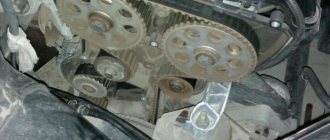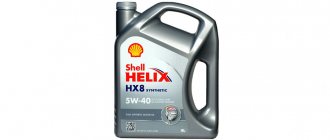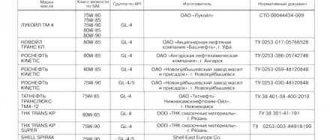Thanks to the close cooperation of the AvtoVAZ concern and Renault, car enthusiasts received a reliable and unpretentious Lada Largus car. This model has become quite popular for many reasons, including functionality, practicality, good build quality and affordable price. Due to the high ground clearance and low overhangs, excellent cross-country ability is ensured, the powerful power plant produces good dynamic characteristics, and the modern steering mechanism, complemented by hydraulic power steering, helps to steer the car with ease.
Characteristics of power steering of Lada Largus
This unit is no less important than the brake system. The safety of the driver and passengers also depends on its performance. Power steering (hydraulic power steering) provides the ability to control the car by easily positioning the drive wheels in the desired direction.
Largus power steering diagram
The Lada Largus is equipped with a combined type hydraulic booster, i.e. some of its elements are located directly in the steering mechanism housing. In other words, they are a component of the mechanical part of the steering column. Power steering Lada Largus consists of a standard set of elements:
- tank;
- power steering pump, complemented by a working fluid bypass valve;
- pipelines;
- redistribution mechanism;
- working mechanism.
There are not many components, which explains the high reliability of the hydraulic booster. Malfunctions associated with its operation occur infrequently. Typically, problems arise due to violations of operating rules by the car owners themselves. Much less often - due to the natural wear and tear of parts, but, of course, one cannot ignore the low quality of components.
Maintenance comes down to following simple rules. The main thing is to regularly check the level of working fluid in the expansion tank of the system. The power steering does not require additional adjustments.
It's easy to check; just open the hood. The fluid in the system is also needed to lubricate the power steering elements. If the level is low, parts will begin to wear out too quickly. With such use, the unit is more likely to fail.
How much to fill
Unlike other LADA models, the refueling volumes of Lada Largus are not presented in the operating manual. Data for the Lada.Online website was provided by one of the LADA dealerships.
| Unit | Volume, l |
| Engine lubrication system -11189 -21129 (cast oil sump) -K7M -K4M | |
| Power steering system (power steering) | 1,2 |
| Hydraulic brake system | 0,7 |
| Air conditioning system with R-134a refrigerant | 0,475 |
Features of the Lada power steering device
The Largus steering mechanism is conventional, rack and pinion type. It is designed on the principle of a gear moving along a rack, but a hydraulic booster is used to ease the applied pressure on the steering wheel. A similar mechanism is common on most passenger cars. This is explained simply: the design consists of a minimum of parts, the efficiency of the power steering is high. Despite its reliability, the power steering mechanism cannot withstand constant movement over potholes and uneven road surfaces, hence the frequent occurrence of vibrations.
A pump with blades is installed on the power steering of Lada Largus, with the help of which it is possible to move oil in the power steering system. The vane pump is located on the engine, where it is mounted on a bracket and built into the timing drive, i.e. the pump blades are driven by the crankshaft drive poly-V belt. This means that you need to tighten the generator belt in a timely manner, although there is a special tensioner roller for this.
The steering mechanism drive structurally has two steering rods connected to the suspension steering knuckle arms at the front using hinge joints. Unlike other VAZ models, the Largus has a subframe on which the steering rack with power steering is mounted in the boot (on all other VAZ models the steering mechanism is mounted on the engine compartment panel).
During the startup of the power plant, the oil in the Largus power steering system moves from the tank through the pressure created by the pump to the distribution valve. When the wheel is turned in one direction or another, using this valve, one of the power steering cavities is connected to the tubes, and the other to the high pressure pipeline. The power steering piston is connected to the steering rack and drives the gear, as a result of which the rack also begins to move. The movement of the rack to the right or left causes the steering knuckles to turn, thus making a turn to the right or left.
Damage to the power steering does not particularly affect the ability to drive the car. The only drawback is the significant increase in effort when necessary to turn the steering wheel.
Reviews
Grigory, Dnepropetrovsk. I drove 110 thousand km on Largus, the car is still holding up. A decent workhorse that is worth the money. This van has paid for itself a long time ago and brings in a stable profit. I give a thumbs up to comfort and multimedia options, as long as the suspension can withstand the loads being transported from point A to point B. The VAZ 1.6 engine consumes around 11 liters in the urban cycle.
Vladimir, Lipetsk region. My wife has a Logan, and I have a more practical seven-seater Largus, suitable for forays into nature over rough terrain. The main advantage of Largus compared to the previous Logan is a lot of space. And in this regard, the station wagon simply cannot have competitors for that kind of money. The unpretentious 1.6-liter engine never fails, the main thing is to fill the oil and filters on time. Average consumption 9 l.
Source
Problems due to low fluid level in the power steering system
There can be many power steering malfunctions on any car, since the design and operating features of the parts imply natural wear and tear. Some things are related to low fluid levels. The main sign indicating an insufficient oil level in the power steering is the need to make significant efforts when turning the steering wheel or a creaking sound when turning the steering wheel of the Lada Largus. This may also indicate a drive malfunction or contamination of the working fluid.
Also, a low fluid level can be confused with a pump malfunction. If there is not enough working fluid in the system, the pump will not be able to pump the required amount of oil into the distribution valve and the actuator will not be able to distribute the load, which will immediately affect the need to apply more force to the steering wheel when turning.
A low power steering fluid level is also accompanied by air entering the system. Air bubbles lead to a decrease in operating pressure in the power steering system. A similar problem also arises due to loss of system tightness. The problem will also be reported by the indicator on the control panel, which transmits readings from the oil level sensor to the power steering.
A decrease in oil level in the power steering system is most often a consequence of a leak. This is one of the most important power steering problems that car owners face. Most often it appears at the point where tubes are connected to parts of the system, for example, to a pump. Leakage also occurs due to damage to the tubes or loss of elasticity of the rubber sealing elements; usually such gaskets are used in all connections of the hydraulic booster system. To eliminate a leak, you must first find the location of the leak; in the case of joints, it is enough to tighten them properly. If the leak is due to damaged tubes, they should be replaced.
Things are more complicated with damaged or worn sealing elements. The main problem is the labor-intensive process, since it is necessary to remove the leaking unit and repair it with replacement of rubber sealing elements. In advanced cases, extraneous sounds occur, indicating failure of the power steering components, and a grinding noise appears when turning.
Comments
TOP materials of the week
TOP products in the store (more)
Your review of the sound insulation of the Lada Largus:
Lada.Online
Lada (“Lada”) is a brand of cars produced by JSC AVTOVAZ. Previously, it was used only for export cars, and for the domestic market, cars were produced under the Zhiguli brand. In 2004, the management of AVTOVAZ announced the transition to the Latin alphabet for the official spelling of the names of all cars produced by the plant: Lada - instead of "VAZ" and "Lada".
Lada.Online is the largest Russian-language automotive resource with a daily audience of thousands, which is dedicated primarily to cars of this brand, the domestic automotive industry and the automotive world in general.
This site is not the official LADA website.
© 2022 Lada.Online. Copying of material is permitted only with a link to the source.
Source
Factory oil and selection rules
Since the Lada Largus is actually an analogue of the Renault Logan, power steering oil from the French model is suitable for this car. In turn, this is confirmed by the manufacturer Largus.
What is recommended to use to replace power steering fluid on Lada Largus
| Conditions | Brand |
| Oil like the “French” Renault Logan has the best viscosity and density indicators, created taking into account operation in Russian conditions at temperatures down to minus 40 degrees, and this turns out to be quite enough for use in the middle zone. | Synthetic or semi-synthetic oil based on the D2 ATF standard, as well as PSF. |
| Pay attention to the service book. | The oil listed there is ELF RENAULTMATIC D2. |
| If the vehicle is actively used and the load on the steering mechanism is significant or the vehicle is used in areas with extremely low temperatures. | In this case, it is recommended to use oil marked D3 or Elf RENAULTMATIC G3. |
In addition to these brands of power steering fluid, the manufacturer recommends some analogues that are as close in their characteristics as possible to the original:
- Mobil ATF 220 or 320;
- Castrol ATF D2 or D3;
- Liqui Moly ATF 1100.
When changing power steering oil yourself, you should keep in mind that you should never mix fluid of different brands.
The result of such mixing will be foaming of the oil and, as a result, failure of the power steering. To replace, you must use the full volume of working fluid. Only compliance with such simple rules and recommendations for monitoring the oil level and choosing the right brand will ultimately lead to stable operation of the entire steering system as a whole. This way you can save money on expensive repairs, and also significantly reduce the risk of getting into an accident due to a faulty steering mechanism.
What technical fluids are filled from the factory?
The information below was provided by the official LADA website.
Engine oil to the engine
:
Transmission oil in the gearbox (gearbox)
:
Coolant (antifreeze)
:
Attention!
This information is for reference only and may be changed by AVTOVAZ without prior notice to the Buyer. For information on recommended working and lubricating fluids, we recommend contacting an official LADA dealer.
Still have questions? Ask in the comments!
Other background information on Lada Largus is provided here.
Share on social networks:
Found an error? Select it and press Ctrl+Enter..
Changing power steering oil on Lada Largus cars
Sooner or later, the system requires replacement of the working fluid, just like in the engine. According to technical regulations, power steering oil filled at the factory is designed for a mileage of no more than 40,000 kilometers or for 2 years of vehicle operation.
Replacement before due date
Changing the working fluid once every 40 thousand kilometers does not mean that you can forget about it and not periodically check its condition in the system. An unscheduled power steering oil change is required in the following cases:
- metal particles in liquid;
- darkening of oil;
- foreign odors.
The reason for replacing the fluid may also be a decrease in its level in the system due to a leak. This is due to the fact that a low oil level in the power steering system causes it to heat up excessively, and this leads to failure of the main power steering components. If the car has not been used for a long time, the oil in the power steering must be changed, since there is a high probability of condensation forming during this time, and this causes the formation of an emulsion. Accordingly, the liquid loses all its basic properties and cannot be used for its intended purpose.
Oil change instructions
Any car owner can change the working fluid in the power steering system. There is nothing complicated here, and there is no need to contact a car service. Do-it-yourself oil change work begins with preparing the following tools and materials:
- about two liters of oil recommended by the manufacturer;
- 20 cc syringe milliliters and a tip with a hose to it;
- socket wrenches;
- a suitable container for draining old oil.
Before starting the replacement procedure, the engine should be warmed up to operating temperature. Then use a syringe and a hose to pump out the liquid from the expansion tank. The further process is as follows.
- The car is installed on an overpass or above an inspection hole; if this is not possible, you can simply lift the front part with a jack.
- Remove the battery and additionally its casing.
- To get to all the necessary pipes at the steering mechanism, you need to remove all the interfering plastic parts.
- Inspect the entire power steering system, thereby identifying any leaks or cracks on the expansion tank.
- Since the liquid has been removed from the tank, it can be dismantled by removing it from its mounts.
- The tube going to the power steering on the steering mechanism is disconnected from the reservoir; be sure to close the fitting on which the tube was installed.
- Finding a drain pipe is not difficult: its size is smaller. After which it is lowered into a suitable container prepared in advance.
- Next, you will need the help of a second person. The assistant must, while in the cabin, turn the steering wheel to the right and left all the way. The waste liquid will be drained into the container. To speed up the process, you can start the propulsion system.
- When draining the fluid, you must remember not to allow air to enter the hydraulic booster system. To avoid such situations, a second person should periodically add oil to the tank. If there is no assistant, you cannot start the engine. It is enough to rotate the steering wheel in both directions until all the liquid has drained from the pipe.
After draining the old fluid, new oil is poured into the tank and the engine starts. Now you need to turn the steering wheel in both directions to the extreme positions. Periodically you need to monitor the fluid level in the tank. When decreasing, add oil and continue manipulating the steering wheel until the level in the tank stops falling and air bubbles appear. After replacement and testing, all that remains is to assemble all the plastic parts and install them in place, then once again check the tightness of the clamps on the connections.
When the power steering fluid is correctly replaced, the steering wheel rotates easily and without the need to apply force (with the engine running).
see also
Comments 30
Pashol couldn’t buy ELF, they offered Castrol to fill it up for half a year, I drive everything normally, I changed everything.
I filled myself with ravenol dexron dII
If you haven't removed the filter from the tank, you won't see oil there. You need to look at the level from the side into the light. I drained the oil and then filled it with new one, 1 liter is enough. The steering wheel turns noticeably easier
I topped up my mobile phone
I replaced it with DEXRON II at 60 thousand. Work has become quieter and easier. There are no problems in winter, but there was no place to really check (we didn’t have it below -10).
I changed the ELF ELFMATIC G3 in the summer, the original one, which was filled in from the factory with a mileage of 50,000 km, was black and smelly, and from the moment I bought the car in December 2015, the pump was howling when it was cold, although they write that it seems like the synthetic mobile was filled in (I doubt it)! So this winter, at minus 30, the pump worked clearly without whining, I’m even surprised how this Elf mineral water works better than mobile synthetics! Maybe they haven’t been pouring this mobile phone at the factory for a long time! A liter of elf was enough for me in full, although I took 2 liters, wanted to replace it, drive 1000 km and replace it again, but I never got around to it, but now everything is fine, so I have a liter left in stock! so I recommend Elf
When is a formal replacement required?
According to the manufacturer, it is advisable to change the power steering oil for the first time after 40 thousand kilometers or after two years of Renault operation. During the same period, the unit is inspected and, if necessary, faulty elements are repaired. But, despite such recommendations, the working fluid may require earlier replacement.
You can talk about replacement if the following symptoms appear:
- Unpleasant stench.
- Darkening of power steering oil.
- The appearance of small metal shavings (garbage) in the composition.
In the mentioned cases, subsequent inspection of the hydraulic booster elements and repair of failed components may be required. If you do not fill in the working fluid (when the level drops) or do not change the composition with the symptoms mentioned above, then the temperature of the lubricating fluid increases, as does the risk of failure of the entire mechanism. In the future, more serious costs for repairing the Renault Logan power steering cannot be avoided. The downside is that the hydraulic boost stops working normally, and it is more difficult for the driver to steer, which increases the risk of getting into an accident.
Antifreeze quality check
You should not trust the numbers on the canister; the indicated replacement period on the packaging does not always correspond to reality. Relying on these figures, it is easy to find yourself in a situation where the antifreeze, having exhausted its service life, ceases to perform its functions. And this will inevitably lead to overheating of the power plant, although replacement is not yet necessary. But you can avoid such situations and the troubles that follow.
It is recommended to learn how to independently determine the quality of antifreeze in the cooling system and, based on this check, make a decision about replacing the fluid.
There are about ten ways to determine quality, but not all of them are available to the average car owner. At home, you can check the coolant yourself using three main methods, which are the simplest and do not require financial investment.
We check it ourselves
| Methods | Your actions |
| Test strips. | Litmus test is familiar to many people from school in chemistry lessons. They can be purchased at any auto parts store; some manufacturers offer them along with antifreeze as an addition. The test is simple: you need to dip a test strip with a reagent in antifreeze, wait five minutes and evaluate the staining result using the operating instructions. This way you can estimate the time until the next replacement. |
| Visual inspection. | Antifreeze that has lost its basic properties can be easily identified by the presence of various foreign impurities (flakes, sediment, sludge, limescale, etc.). The quality can also be judged by the color of the liquid: a cloudy color indicates the need for an early replacement. |
| Boiling. | To check quality, you can boil antifreeze. It is worth using a small amount of liquid, for example, heating a tablespoon with coolant on a gas burner or stove. If the smell of ammonia (ammonia) is clearly felt when boiling, it means the antifreeze is of low quality or it is a fake. It is better not to use such liquid. It is much more dangerous when a precipitate of copper sulfate granules forms when heated. When using such a liquid in a car, the granules will clog the cooling system channels, which will ultimately lead to overheating of the power unit. |
Knowing these simple methods, you can quickly determine the quality of the coolant at home. This way you can avoid problems with a low-quality product.
Rules for choosing coolant
The cooling system of the Lada Largus car holds 5.45 liters of antifreeze, it is recommended to purchase at least 6 liters for replacement; the remaining volume can be used for topping up during operation or if leaks occur (broken pipe, loss of radiator tightness, leakage due to weak clamps and etc.).
For the Lada Largus, the manufacturer recommends filling in Glacoel RX brand coolant; this is the antifreeze that is filled in at the factory. When choosing an alternative option, it should be taken into account that the liquid must correspond to D-class. This means that it is produced on the basis of ethylene glycol, to which a distillate, most often water, is added. As an analogue, you can use the Motul Inugel Optima Ultra brand. A similar brand is also used on Renault cars. In general, you can choose another option from a large assortment, the main thing is that it matches the basic parameters.
Question about mixing
Many motorists doubt whether it is possible to mix different antifreeze. Such questions arise due to the fact that some manufacturers use the same antifreeze (i.e., the chemical composition is identical), but compositions of different colors are used as dyes. As it were.
Mixing refrigerant of different colors, much less different brands, is not allowed.
The fact is that antifreezes with different chemical compositions, when mixed, can do more harm than good. Some car owners experiment with various refrigerants at their own risk. But repeating their actions is not recommended.
In the operating manuals of many cars and Lada Largus in particular, it is written that manufacturers of coolant for painting add a special component to the composition. But the color of the stain will depend on the specific chemical composition of the liquid. When choosing by color, it is also recommended to focus on the shade of the factory refrigerant.
Application area
Mobile ATF 52475 transmission oil can be used in any automatic transmission of passenger cars, SUVs, mini-trucks, and also as a power steering fluid if it meets the manufacturer's approvals.
Approved for use in Allison C-4, Ford Mercon, General Motors Dexron III transmissions. This oil for transmissions and power steering is recommended by Mercedes-Benz, Renault, MAN and LADA LARGUS, LADA X-Ray. In particular, this fluid is poured into the power steering on the Lada Largus at the factory.
Can be used in any climatic and road conditions, including extremely difficult ones.
Why you can’t save money when choosing power steering fluid
When choosing power steering fluid, you should pay attention to well-known manufacturers of car accessories. It is better to purchase such consumables in specialized stores for car enthusiasts, since they directly affect traffic safety
Low-quality power steering fluid may have the following disadvantages: Loss of properties at elevated temperatures. During operation, the power steering fluid on some cars “heats up” above 100 degrees Celsius. Oil with poor quality additives may begin to coagulate at such high temperatures that it will cause difficulty turning the steering wheel. Particularly low-quality power steering fluids can completely damage the power steering at high temperatures. In such a situation, the steering will continue to work, but after that the driver will have to repair the power steering elements;
Release of hazardous fumes for vehicle occupants. The amount of chemical reagents mixed into power steering fluid is no less than in car additives. At elevated temperatures, power steering fluid emits vapors that can be hazardous to the health of passengers. If you purchase such oils in specialized stores and from trusted brands, you don’t need to worry about harmful vapors, while in an effort to save money when purchasing secondhand, you can end up with a liquid containing harmful or even dangerous elements.
Replacement, all phases
There are two different standards, DEXRON II and DEXRON III. And it seems that what kind of oil to fill in the Renault Logan power steering is clearly indicated in the documentation.
Renault fuel selection table
But if you don’t consider yourself smarter than the engineers at Avtoframos and VAZ, then you should pour DEXRON III. In addition, for these oils there is a test result from the magazine “Behind the Wheel”.
Top Ten
Unfortunately, the tests were carried out several years ago. Therefore, some modern materials are not on the list - Motul Multi HF or Motul Multi ATF, for example.
Good oil of DEXRON III standard for power steering
The list below contains time-tested options, and they are listed in order “starting from best”:
- ENEOS ATF III – “Number 1 Oil in Japan”, frost resistance – up to -46 C.
- ZIC Dexron III – semi-synthetic, low viscosity. Freezes at -40 C.
- Bizol ATF III – excellent frost resistance (-47 C), almost no foaming, but the color does not meet the standards (yellow).
- Mobil ATF D/M – good frost resistance and full compliance with its standard.
- BP Autran DX III - not the best lubricating properties.
- Luxoil ATF Dexron III – the best frost resistance (-48 C), there are no other obvious advantages.
- XADO ATF III – does not foam, lubricates well, but does not meet the requirements for corrosion resistance.
- Castrol Automatic TQ Dexron III is another “puncture with corrosion”.
- Mannol Dexron III Automatic Plus - synthetic (not suitable). No corrosion resistance.
- Elf Elfmatic G3 - in “Behind the Wheel” they placed this material in tenth place for one reason: oil actively dissolves copper.
There is no copper in the power steering system, and the last option will be one of the most suitable! Make a choice.










